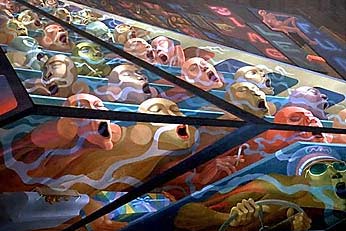Born Irving Noachowitz in Poland, 1906. His family emigrated to the United States in 1923. He was your typical young man until going to Spain in 1938 to fight for the Republic in the Spanish Civil War. He returned to the States in 1940 a changed man... How many young minds have been distorted and forever altered by the horrible reality of war?
Having seen the true, horrific nature of Man at his worst, Irving channeled his frustrations and terrifying visions into art. He saw what Man really was: an animal. After facing the battlefield, he knew humanity's true face, and he saw what he felt to be a possible future and reality for us all... Most of his work is a little confusing at first glance; many repeating shapes and themes, with somewhat incongruous elements, usually a very dark color pallette. I remember seeing his work for the first time and, though I liked it, it's true meaning eluded me. It wasn't until one fateful evening while looking at his work, that the true meaning of it reality-checked me right in the teeth.
Norman's work showed a terrible world where the Elite reigned supreme and the rest of us, the endless blue collar masses, were but more meat for the grinder. His paintings showed that we the people were nothing but numbers, a seething, writhing mass of blissfully ignorant victims for the Machine. His vision terrified me; it couldn't be true... But the more I looked at them, I could not deny the truth of his paintings.
His paintings are huge in scale, sometimes as large as 9 Feet tall and 15 Feet wide, allowing him to pack even the most minute details into them. Paintings like The Bus (1953), featured hundreds of people (all with completely unique features) packed into a bus, detailing the cold, harsh reality of surviving in what he called the "Dark Metropolis."
Despite the bleak, dismal content of his art, Irving Norman is amongst my favorite artists. His un-flinching and un-apologetic view of society are visual cautionary tales of what not to do with one's society. Whether or not he's speaking directly about government control or if he's commenting on people's willingness to give up their freedom and individuality, the shocking imagery is enough to rattle the apathy right out of you.
Either way, I feel that his art tells a story everyone needs to hear at least once.
The Bus (1953):
In Blind Momentum, he shows Man's headlong rush to dehumanize ourselves in as short a time as we possibly can.
Blind Momentum (1960):
Martyred (1971):
Irving Norman passed away in 1989, leaving behind hundreds of works of art, most of which he reffered to as "Social Surrealism". His scary, scathing and undeniably accurate social commentary is, I feel, even more relavant now than it was while he was still with us. It seems to me that even just the phrase Blind Momentum describes our current trajectory more so than just about any other current synopsis by even the most learned sociologist. Where are we going and why? What is happening to us? Why has apathy, greed, cruelty and banality become the accepted modes and memes of our world? We're on a shit machine of perpetual motion, and most of the people of this country seem absolutely ignorant of it. Irving began seeing, predicting and painting this vision more than 70 years ago.
Learn more about Irving Norman and his work here and here
Learn more about Irving Norman and his work here and here







No comments:
Post a Comment